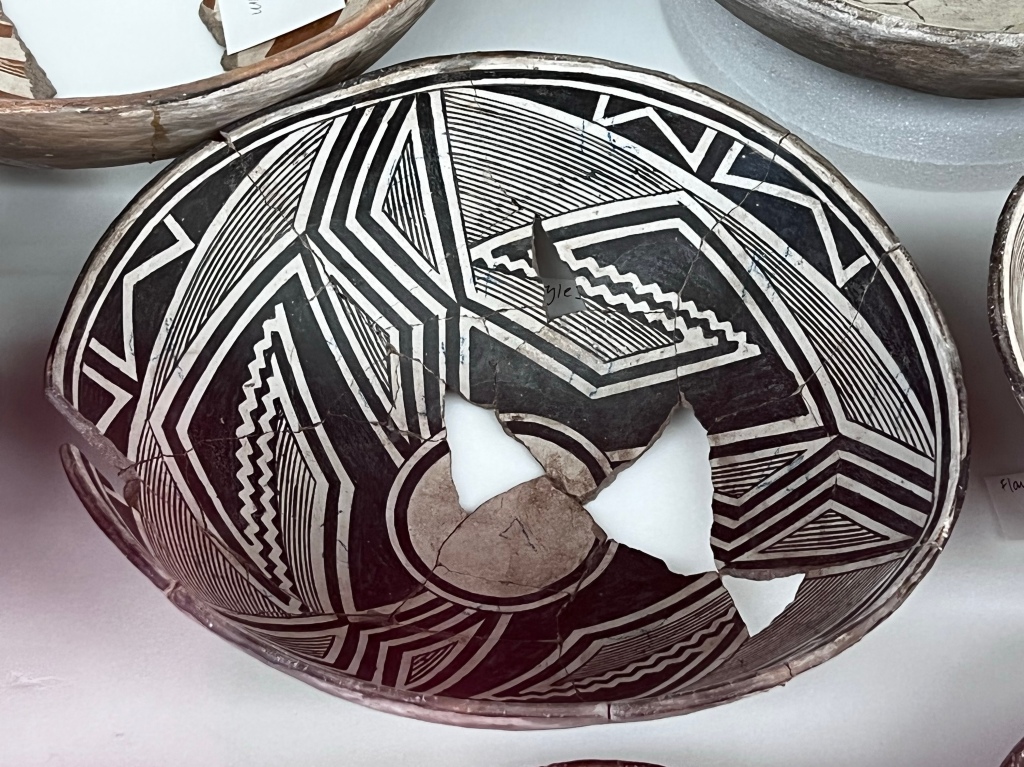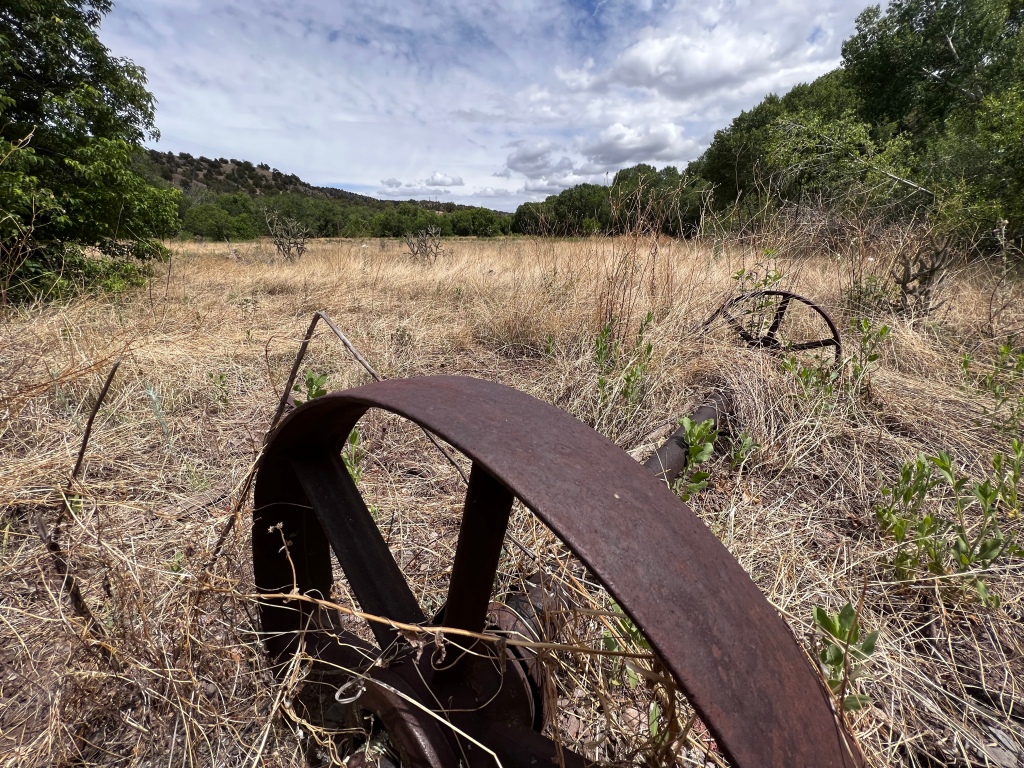In September 2020 I wrote an article on the Mimbres pottery collection at Western New Mexico University. I wrote the article during Covid, so I was unable to visit the museum at the time. Today, that changed.

Although WNMU is a small university, their collection of Mimbres ceramics is outstanding. Simply outstanding. I’m told that more of the collection will be on display in the near future, which may warrant a return trip. (That’s saying something: I drove 675 miles (1,000 km) down here to see this collection and explore the Mimbres Valley where this culture thrived for 1,000 years and then faded or disbursed 800 years ago.)
There’s a lot of mystery about these people and their culture which, artistically speaking, peaked in what is referred to as the Mimbres Classic period around 1000 – 1150 AD). The Museum does a good job documenting the 900 year run-up (200 – 1100 AD) to this magnificent Classic period, and of course the Museum also contains extensive examples of Classic period pieces.


I’m not particularly interested in a stylistic analysis of Mimbres pottery (i.e., what distinguishes on Mimbres phase from another). I enjoy the pottery for its aesthetic qualities. Here’s what I observe when I look at Mimbres pottery.
I’m first impressed by a sense of “balanced contradiction”. Many pieces slap me with an intense sense of energy and chaos. Black decor on white slip communicates strong graphic tension and contrast. It’s about as vibrant and dynamic as you can achieve on a 2D surface — I’m reminded of the ZAP! and POW! of comic book graphics — and Mimbres artists mastered this form of graphic tension more than 1,000 years ago.

Yet what first appear to be randomly aligned graphic elements (swirls, rectangles, triangles, etc) upon reflection follow clear rules of organization: lines are painted around the rim of bowls or to set off a white central space, lines delineate 3- or 4-areas of the inner bowl surface, lines also interconnect and tie decorative elements together. All of these techniques provide an organizational structure for the graphic elements.


In short, Mimbres bowls are rarely “chaotic.” There is an underlying order to their graphic elements. A structure. A logic.


In addition, at times individual Mimbres bowls are interestingly calm and serene. Two patterned fish swim on a plain ground. An individual grasshopper sits in a field of white, carefully observed, meticulously represented. In this respect WNMU’s sometimes closely spaced display of Mimbres pots in the downstairs rooms works well. It’s probably not calculated, but I love the tangled mess of pottery in the downstairs cases. You see intricately decorated pots almost throbbing with kinetic energy alongside simple pots with isolated animal or humanoid figures. I’ve tried to capture this dichotomy in a quick video scrolling across pots in one showcase.
Individual pots with depictions of small animals that you see in the video lead me to my second observation. There’s a strong connection between Mimbres pottery and the environmental context of the Mimbres River basin.

Before I came here, I assumed the Mimbres people lived in an austere environment, largely desert as would be suggested by their location in southern New Mexico. In fact the Mimbres River valley is lush and verdant.

The grasslands rising out of the river basin are full of piñon pine and game. Antelope, rabbits, turkeys, frogs, insects and fish are depicted in Mimbres pottery because they exist in this southern New Mexican landscape. The Mimbres artists painted what they knew.

Coincidentally, I followed the Mimbres River south toward the current US-Mexican border. After starting in pine-covered mountains and winding 30-40 miles south, the Mimbres River dissolves into the desert sands. Like the Mimbres villages that once dotted the riverbanks, the river itself has disappeared into the earth. While vanishing leaving not much more than ceramics and crumbled architectural foundations is not unique to the Mimbres people, that is definitely what happened.

I suppose that’s my third reaction to viewing Mimbres pots in the WNMU collection: cultures come and go. Sometimes not much is left in their wake except for pieces of ceramic with a few scratches or paint marks on them. It gives me some comfort being a ceramicist.

I’ve enjoyed this visit to the WNMU Museum. I based myself in Silver City, New Mexico. It’s a funky throw-back to a different era. (My morning coffee place, Tranquilibuzz, looks like some undisclosed location on the overland route to Asia circa 1972.) If you come here, take 3-4 hours to drive over to the Mimbres River valley (20 miles) and explore a bit. There’s a riparian preserve along the Mimbres River that’s delightful. It drops you into context. Poke around a little. I wandered into the neighboring hills and discovered an old clay mine just a short distance from the river. This is a beautiful area.
These are wonderful. So many examples of ceramics from early periods worldwide seem to make use of a similar aesthetic. And such a successful one.
LikeLike
I’m glad you enjoyed these samples. The WNMU collection is large. I was tempted to put more examples in but I didn’t want to overdo things.
LikeLiked by 1 person
Very nice article. What terrific work they did, this a great chance to it. Thanks.
LikeLike
Just looking at the map to see if I can incorporate at least some of this on my next road trip. I’d like to see the valley as well as the collection.
LikeLike
The route north is New Mexico State Highway 35, which intersects with State Highway east of Silver City. The route south is New Mexico State Highway 61. As you go south on 61 the river peeters out and disappears into the sand. Highway 61 ultimately connects with Highway 180 running south to Deming. About 2 miles before the intersection of highways 61 and 180 there is a hot springs, called Faywood Hot Springs. Bring your swim suit!
LikeLike
Hi John,
I truly enjoyed answering your blog questions and providing photographs for your original article on the Western New Mexico University Museum during the pandemic. This–your visit to see the museum and its collections in person, and experiencing the environment of the Mimbres which resulted in this most excellent blog post–is wonderful and satisfying. The new WNMU Museum Director, Danni Romero, is doing an incredible job of reconstructing some of the 10s, maybe 100s, of vessels in the collections and placing them on exhibition. I look forward to seeing her move the museum into the future expanding interpretative exhibitions and programs.
I hope you will have the opportunity to visit the museum over and over again, and your readers will have the opportunity to visit and/or revisit the museum in the future.
Sincerely,
Dr. Cynthia Ann Bettison-Jones, Ph.D., RPA, CMO
Director Emerita, Western New Mexico University Museum
LikeLike